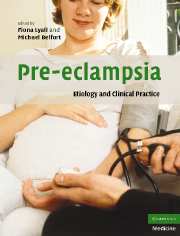Book contents
- Frontmatter
- Contents
- List of contributors
- Preface
- Part I Basic science
- Part II Clinical Practice
- 17 Classification and diagnosis of pre-eclampsia
- 18 Measuring blood pressure in pregnancy and pre-eclampsia
- 19 Immune maladaptation in the etiology of pre-eclampsia; an updated epidemiological perspective
- 20 Genetics of pre-eclampsia and counseling the patient who developed pre-eclampsia
- 21 Thrombophilias and pre-eclampsia
- 22 Medical illness and the risk of pre-eclampsia
- 23 The kidney and pre-eclampsia
- 24 Management of mild pre-eclampsia
- 25 Management of severe pre-eclampsia
- 26 The differential diagnosis of pre-eclampsia and eclampsia
- 27 Complications of pre-eclampsia
- 28 Central nervous system findings in pre-eclampsia and eclampsia
- 29 Pathogenesis and treatment of eclampsia
- 30 Anesthesia for the pre-eclamptic patient
- 31 Critical care management of severe pre-eclampsia
- 32 The role of maternal and fetal Doppler in pre-eclampsia
- 33 Pregnancy-induced hypertension – the effects on the newborn
- 34 Medico-legal implications of the diagnosis of pre-eclampsia
- Subject index
- References
29 - Pathogenesis and treatment of eclampsia
from Part II - Clinical Practice
Published online by Cambridge University Press: 03 September 2009
- Frontmatter
- Contents
- List of contributors
- Preface
- Part I Basic science
- Part II Clinical Practice
- 17 Classification and diagnosis of pre-eclampsia
- 18 Measuring blood pressure in pregnancy and pre-eclampsia
- 19 Immune maladaptation in the etiology of pre-eclampsia; an updated epidemiological perspective
- 20 Genetics of pre-eclampsia and counseling the patient who developed pre-eclampsia
- 21 Thrombophilias and pre-eclampsia
- 22 Medical illness and the risk of pre-eclampsia
- 23 The kidney and pre-eclampsia
- 24 Management of mild pre-eclampsia
- 25 Management of severe pre-eclampsia
- 26 The differential diagnosis of pre-eclampsia and eclampsia
- 27 Complications of pre-eclampsia
- 28 Central nervous system findings in pre-eclampsia and eclampsia
- 29 Pathogenesis and treatment of eclampsia
- 30 Anesthesia for the pre-eclamptic patient
- 31 Critical care management of severe pre-eclampsia
- 32 The role of maternal and fetal Doppler in pre-eclampsia
- 33 Pregnancy-induced hypertension – the effects on the newborn
- 34 Medico-legal implications of the diagnosis of pre-eclampsia
- Subject index
- References
Summary
Introduction
Eclampsia refers to the occurrence of one or more generalized convulsions and/or coma in the setting of pre-eclampsia and in the absence of other neurologic conditions. Pre-eclampsia is a multisystem disorder of pregnancy and the puerperium, complicating approximately 6–8% of all pregnancies (ACOG, 1996, 2002). Pre-eclampsia is characterized by new onset hypertension (sitting blood pressure ≥140/90), proteinuria (≥2+ in a random urine sample or ≥300 mg in a 24-h collection) with or without non-dependent edema after 20 weeks' gestation. Eclampsia was at one time thought to be the end result of pre-eclampsia, hence the nomenclature. It is now clear, however, that seizures are but one clinical manifestation of “severe” pre-eclampsia. Other manifestations include, among others, HELLP syndrome (Hemolysis, Elevated Liver enzymes and Low Platelets), disseminated intravascular coagulopathy (DIC), renal failure, hepatocellular damage, pancreatitis, congestive cardiac failure, pulmonary edema and fetal intrauterine growth restriction.
The pathophysiology of pre-eclampsia is poorly understood. It is a disease of human pregnancy; more precisely, it is a disease of the placenta since it is also described in pregnancies where there is trophoblast but no fetal tissue (complete molar pregnancies) (Goldstein and Berkowitz, 1994). The blueprint for the development of pre-eclampsia is laid down early in pregnancy. The pathologic hallmark of pre-eclampsia appears to be a failure of the second wave of trophoblast invasion from 8 to 18 weeks' gestation, a process that is responsible for destruction of the muscularis layer of the spiral arterioles and, as such, establishment of the definitive uteroplacental circulation (Brosens et al., 1972; Cross et al., 1994; Meekins et al., 1994).
- Type
- Chapter
- Information
- Pre-eclampsiaEtiology and Clinical Practice, pp. 437 - 450Publisher: Cambridge University PressPrint publication year: 2007



